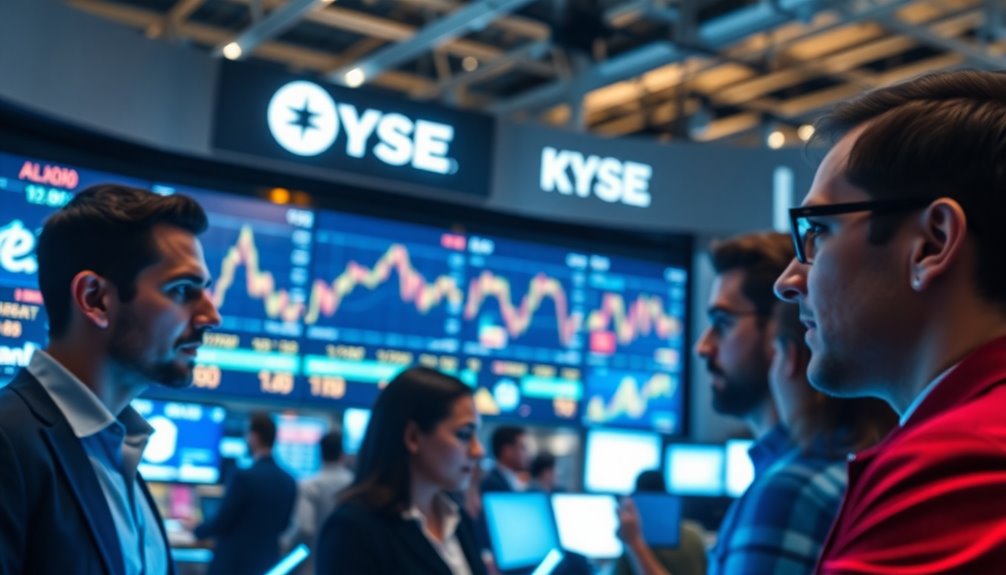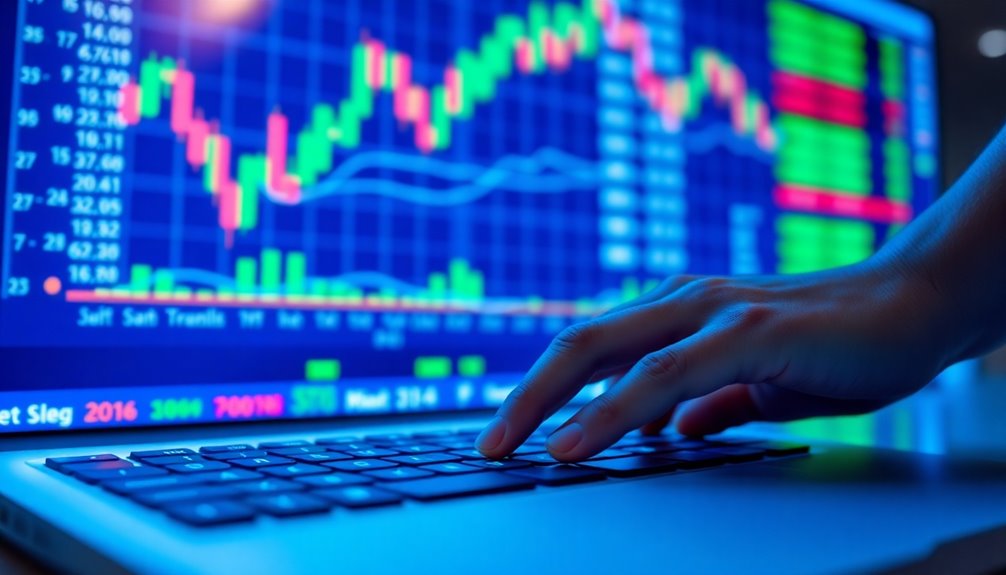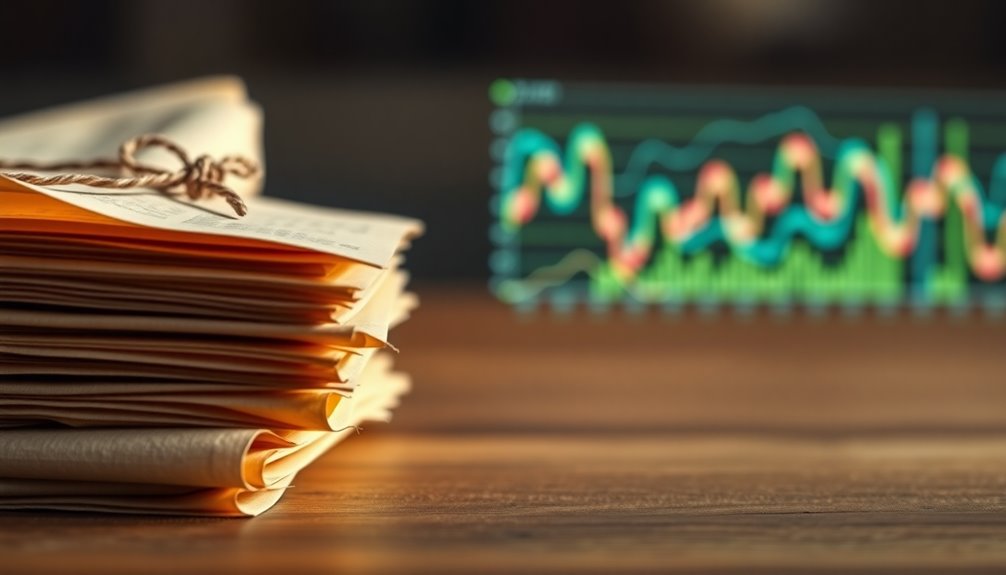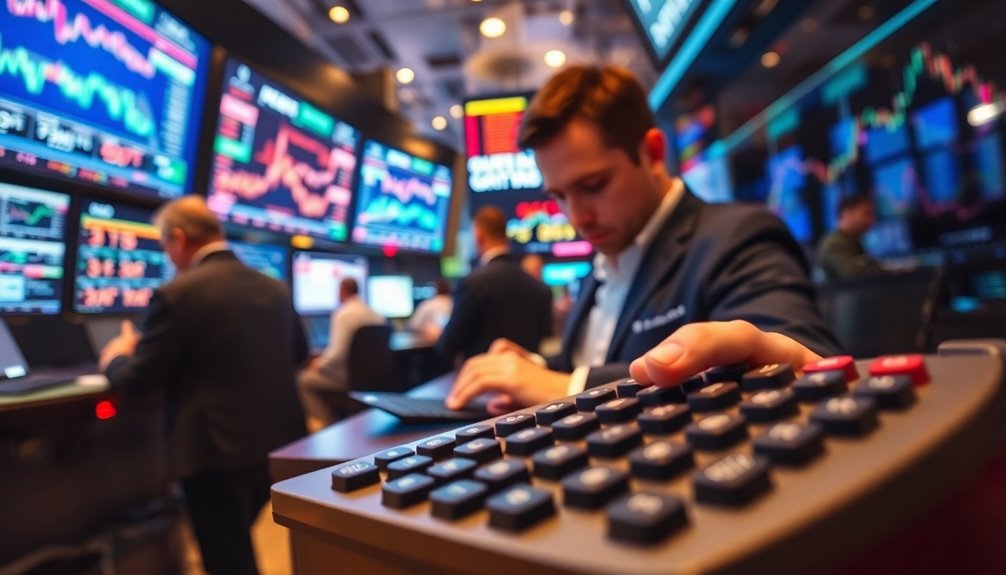Perpetual futures are innovative derivative contracts that let you trade without an expiration date. This means you can hold your positions indefinitely, giving you great flexibility in a dynamic market. They're especially popular in cryptocurrencies, allowing you to speculate on price movements with high leverage. A key feature is their funding mechanism, which keeps prices aligned with the underlying asset's spot price through periodic payments. While they offer advantages like high liquidity, they also come with risks such as market volatility and potential liquidation. If you're intrigued by their trading strategies, you'll find even more insights ahead.
Key Takeaways
- Perpetual futures are derivative contracts that allow traders to hold positions indefinitely without an expiry date.
- They include a funding mechanism that ensures prices align closely with the underlying asset's spot price.
- Traders can utilize high leverage and liquidity, maximizing potential profits with minimal capital.
- Regular funding rate adjustments incentivize traders to reduce price discrepancies between futures and spot prices.
- Market volatility and external events can significantly impact trading outcomes and funding rates, requiring diligent monitoring.
Key Features Overview

When exploring the world of perpetual futures, you'll find several key features that set them apart from traditional futures contracts.
First, there's no expiry date, allowing you to hold positions indefinitely without worrying about contract rollovers. This flexibility enhances your trading strategies.
The funding mechanism, involving periodic payments between long and short positions, helps keep the contract price aligned with the underlying asset's spot price. This funding mechanism is crucial for ensuring that the price alignment between perpetual futures and the underlying asset's spot price remains consistent.
Additionally, perpetual futures are designed to closely track this spot price, ensuring your trades reflect real market conditions.
High leverage and liquidity mean you can control larger positions with less capital and enter or exit trades quickly.
These features come together to create a dynamic and efficient trading environment tailored for modern traders.
Understanding Perpetual Contracts

Perpetual contracts are a unique financial instrument that merges the flexibility of traditional futures with the advantages of a spot market.
You can take advantage of various trading strategies, like speculation and trend following. Speculation lets you profit from price movements without owning the asset, while trend following involves entering positions based on market momentum. Additionally, the absence of an expiration date in perpetual futures allows for continuous position holding, which can enhance trading strategies.
These contracts offer significant benefits, including flexibility and liquidity, as you can hold positions indefinitely without worrying about expiry dates.
However, be cautious of the risks; leverage can amplify both profits and losses, increasing the chance of liquidation.
Understanding these dynamics is crucial for effectively managing your trades and maximizing potential gains in this evolving market.
Mechanism of Funding Rates

To keep perpetual futures contract prices aligned with the underlying asset's spot price, the funding rate mechanism plays a crucial role. It ensures these prices stay close by incentivizing you and other traders to take positions that reduce any discrepancies. The funding rate is calculated based on the difference between the contract price and the spot price, incorporating an interest rate reflecting borrowing costs. A premium index may also be used to capture market activity. Payments are made every eight hours; if the funding rate is positive, you pay shorts, and if negative, shorts pay you. This mechanism reflects market sentiment, helping maintain balance and preventing significant price deviations from the spot price. Additionally, the funding rate is adjusted regularly to keep the perpetual market prices close to the Index Price.
Pros and Cons Summary

Navigating the world of perpetual futures comes with its own set of advantages and disadvantages.
On the plus side, you enjoy no expiry date, high liquidity, and the ability to use leverage, which can amplify your profits. The flexibility of these contracts suits both long-term and short-term strategies, while lower trading costs can enhance your profitability. Additionally, perpetual futures allow for indefinite speculation on prices, providing traders with more opportunities to capitalize on market movements.
However, keep in mind that holding these contracts can incur funding costs and expose you to market volatility. The risk of over-leverage and potential liquidation requires careful management. Additionally, you must be wary of market manipulation risks, as sudden changes can impact your positions. Balancing these pros and cons is crucial for effective trading in perpetual futures.
Perpetual vs. Traditional Futures

While both perpetual and traditional futures offer unique trading opportunities, their fundamental differences can significantly impact your trading strategies.
Perpetual futures have no expiry dates, allowing you to hold positions indefinitely and trade 24/7 without the hassle of rollovers. In contrast, traditional futures come with fixed expiration dates, requiring you to settle contracts or rollover before maturity, which can complicate your trading plans.
The funding rate mechanism in perpetual futures helps keep contract prices aligned with the spot market, while traditional contracts involve settlement processes that can lead to additional costs. Additionally, these contracts allow for indefinite position holding without rollovers, providing traders with more flexibility.
Moreover, perpetual futures allow for greater leverage, enhancing both potential profits and risks, making them particularly appealing in volatile markets like cryptocurrencies.
Market Volatility Impacts Pricing

Market volatility significantly impacts the pricing of perpetual futures, creating a dynamic landscape for traders.
When volatility spikes, perpetual futures prices can deviate sharply from spot prices, sometimes by 60% to 100% annually. This discrepancy leads to increased funding rates, encouraging traders to align prices. Additionally, high leverage contributes to the risk of significant losses during these periods.
If you're trading during these volatile periods, expect rapid market reactions; your strategy may need constant adjustment.
Additionally, high volatility can affect liquidity, making it tricky to enter or exit positions without causing significant price shifts.
Remember, leveraging your positions amplifies risks, so managing your margin requirements is crucial to avoid liquidation.
Staying aware of these factors will help you navigate the complexities of perpetual futures pricing effectively.
Emerging Platforms Gaining Popularity

As the cryptocurrency landscape evolves, emerging platforms are quickly gaining popularity among traders seeking innovative solutions and competitive features.
Bybit stands out with its advanced trading services, processing an impressive $10 billion in daily volume while offering up to 100x leverage. Notably, it is recognized as the best platform for perpetual futures trading due to its user-friendly interface and extensive contract options.
MEXC follows closely, boasting zero futures maker fees and support for over 350 trading pairs.
Meanwhile, dYdX revolutionizes trading with its decentralized model, allowing for instant trades and governance through its DYDX token.
Other notable platforms like Phemex and Bitget cater to various trading needs, enhancing options for traders.
With user-friendly interfaces and advanced tools, these emerging platforms make it easier than ever to navigate the world of perpetual futures.
Leverage Risk Management Techniques

Effective leverage risk management techniques are crucial for navigating the high-stakes environment of perpetual futures trading. Using leverage allows you to control larger positions with less capital, but it can amplify both profits and losses. For instance, with 10x leverage, a $10,000 position requires only $1,000, yet small price movements can deplete your capital quickly. To mitigate this risk, set stop loss orders based on your risk tolerance to automatically close positions when the market turns against you. Additionally, manage your position sizes by diversifying your portfolio and adjusting based on market conditions. Furthermore, the absence of an expiry date means that positions can be held indefinitely, which adds another layer to your trading strategy. Finally, keep an eye on market volatility and funding rates, as these factors can significantly impact your trading strategy and overall risk exposure.
Frequently Asked Questions
Can Perpetual Futures Be Traded 24/7?
Yes, you can trade perpetual futures 24/7.
This continuous trading means you're free to enter or exit positions at any time, enhancing your flexibility.
With no specific closing times, you can react to market movements as they happen, which boosts liquidity and efficiency.
Just keep in mind that while you have the freedom to trade anytime, managing your risk is crucial to avoid potential losses in such a dynamic environment.
What Types of Assets Can Be Traded as Perpetual Futures?
Imagine a marketplace where time stands still, and you can trade endlessly.
In this realm, you can dive into cryptocurrencies like Bitcoin and Ethereum, ride the waves of commodities like oil and gold, or even navigate the currents of financial indices.
You're not just trading; you're speculating and hedging against risks.
With perpetual futures, the possibilities are vast, allowing you to explore various assets without the constraints of physical ownership.
Are There Tax Implications for Trading Perpetual Futures?
Yes, there are tax implications for trading perpetual futures.
Depending on your jurisdiction, these contracts mightn't fall under the same tax rules as traditional futures.
You need to be aware of how gains and losses are treated, as regulations can vary significantly.
It's essential to consult a tax professional to navigate the complexities, especially regarding potential offsets and the impact of high volatility and leverage on your tax situation.
How Do I Choose a Platform for Trading Perpetual Futures?
When you choose a platform for trading perpetual futures, prioritize user-friendly interfaces, robust security features, and high liquidity.
Seek high-performance trading engines, competitive trading fees, and a variety of asset options.
Understand the margin requirements and risk management tools available.
Check user reviews for reliability and ensure responsive customer support is accessible.
Lastly, look for platforms that offer educational resources to enhance your trading skills and confidence.
What Strategies Can I Use for Trading Perpetual Futures?
When trading perpetual futures, you can use several strategies to enhance your chances of success.
Consider speculation, where you take long or short positions based on market expectations.
Trend following helps you capitalize on market movements by using technical analysis tools.
Arbitrage allows you to exploit market price discrepancies, while hedging protects your existing positions from potential losses.
Conclusion
In the ever-shifting landscape of cryptocurrency trading, perpetual futures offer you a unique vehicle to navigate the waves of market volatility. While they come with their own set of risks and rewards, understanding their mechanics can help you ride the tide more confidently. As you explore emerging platforms and leverage techniques, remember that knowledge is your compass, guiding you through the tumultuous waters of trading. Embrace the challenge, and let perpetual futures propel you toward your financial goals.









